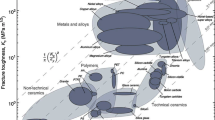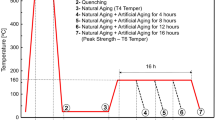Abstract
The behavior of remanence M r, initial permeability μ, and coercive force H c of the steels during their plastic tension in both loaded and unloaded states upon “slow” and “rapid” loading is explained from a unified point of view. It is shown that (1) a sharp (severalfold) decrease in M r and μ and a similar abrupt increase in H c are caused by the same effect, namely the appearance of high residual compressive stresses in most grains along the force direction; (2) in the loaded state, M r and μ slowly decrease and H c similarly slowly increases with increasing degree of deformation ε due to a common effect of increasing dislocation density ρ with increasing ε; (3) the values of M r, μ, and H c in the transition region, in which ε ≤ εcr, substantially differ from each other upon “slow” and “rapid” loadings; (4) at ε ≥ εcr, the dependences of the M r, μ, and H c parameters on ε both in the loaded and unloaded states are parallel to each other.
Similar content being viewed by others
References
V. G. Kuleev and E. S. Gorkunov, “Mechanisms of the Effect of Internal and External Stresses on the Coercive Force of Ferromagnetic Steels,” Defektoskopiya, No. 11, 3–18 (1997).
V. G. Kuleev, G. V. Bida, and L. V. Atangulova, “Feasibility of NDT of Ferromagnetic Steel Structures Based on Measurements of Residual Magnetization as a Function of Elastic Stress,” Defektoskopiya, No. 12, 7–20 (2000) [Rus. J. Nondestr. Testing 36 (12), 866–876 (2000)].
V. G. Kuleev and L. V. Atangulova, “Effect of Elastic Stresses on the Reversible Susceptibility of Ferromagnetic Steels in Various Magnetic States,” Fiz. Met. Metalloved. 87(5), 52–57 (1999) [Phys. Met. Metallogr. 87, 409–414 (1999)].
S. Chikasumi, Physics of Ferromagnetism. Magnetic Characteristics and Engineering Application (Syokabo, Tokyo, 1984; Mir, Moscow, 1987).
H. Wohlfarth, “Effect of Residual Stresses,” in Steel Behavior upon Cyclic Loading, pp. 243–279 (Metallurgiya, Moscow, 1983) [in Russian].
M. L. Bernshtein and V. A. Zaimovskii, Structure and Mechanical Properties of Metals (Metallurgiya, Moscow, 1970) [in Russian].
N. N. Malinin, Applied Theory of Plasticity and Creep (Mashinostroenie, Moscow, 1968) [in Russian].
I. N. Khristenko and V. V. Krivova, “Effect of Plastic Deformation on the Coercive Force of Low-Carbon Steels,” Defektoskopiya, No. 6, 90–92 (1984).
S. M. Tompson and B. K. Tanner, “The Magnetic Properties of Specially Prepared Pearlitic Steels of Varying Carbon Content as a Function of Plastic Deformation,” J. Magn. Magn. Mater. 132, 71–88 (1994).
Langman, R., “Magnetic Properties of Mildsteel under Conditions of Biaxial Stress,” IEEE Trans. Magn. 26 (4), 1246–1251 (1990).
G. Ya. Bezlyud’ko, V. F. Muzhitskii, and B. E. Popov, “Magnetic Control of the Stress-Strain State and Residual Reserve of Steel Structures,” Zavod. Lab. 65(9), 53–57 (1999).
G. T. Orekhov, “A Relation of Magnetoelastic Effect with Stresses and Deformations upon Plane-Strain State,” Defektoskopiya, No. 3, 100–105 (1975).
V. A. Zakharov, M. A. Borovkova, V. A. Komarov, et al., “Effect of External Stresses on the Coercive Force of Carbon Steels,” Defektoskopiya, No. 1, 41–46 (1992).
V. G. Kuleev, T. P. Tsar’kova, and A. P. Nichipuruk, “Specific Features of the Behavior of the Coercive Force in Low-Carbon Plastically Deformed Steels,” Defektoskopiya, No. 5, 24–39 (2005) [Rus. J. of Nondestructive Testing 41 (5), 285–295 (2005)].
R. Dawson and D. G. Moffat, “Vibratory Steels Relief: A Fundamental Study of Its Effectiveness,” J. Eng. Mater. Techn. 102, 1–9 (1980).
B. N. Goshchitskii and A. Z. Menshikov, Neutron News 7, 12 (1996).
H. M. Rietveld, “A Profile Refinement Method of Nuclear and Magnetic Structure,” J. Appl. Cryst. 2, 65–71 (1969).
J. Rodriguez-Carvajal, “Recent Advances in Magnetic Structure Determination by Neutron Powder Diffraction,” Physica B 192, 55–69 (1993).
Author information
Authors and Affiliations
Additional information
Original Russian Text © V.G. Kuleev, T.P. Tsar’kova, A.P. Nichipuruk, V.I. Voronin, I.F. Berger, 2007, published in Fizika Metallov i Metallovedenie, 2007, Vol. 103, No. 2, pp. 136–146.
Rights and permissions
About this article
Cite this article
Kuleev, V.G., Tsar’kova, T.P., Nichipuruk, A.P. et al. On the origin of essential differences in the coercive force, remanence, and initial permeability of ferromagnetic steels in the loaded and unloaded states upon plastic tension. Phys. Metals Metallogr. 103, 131–141 (2007). https://doi.org/10.1134/S0031918X07020032
Received:
Accepted:
Issue Date:
DOI: https://doi.org/10.1134/S0031918X07020032




